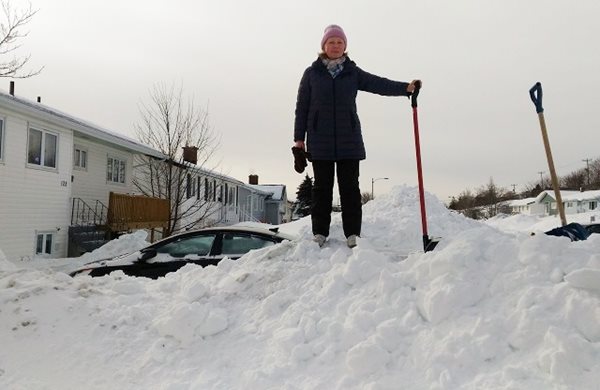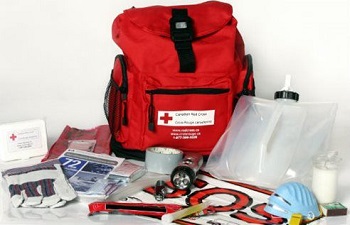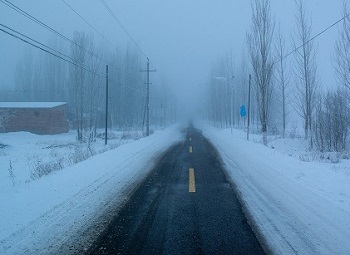In this series, newcomers will learn how to be better prepared for the risks and realities that come with Canadian winter. Discover practical tips for cold weather safety, first aid and emergencies like snowstorms and power outages.
 Across Canada, winter can take many forms, ranging from wild storms to bone-chilling power outages. While many Canadians are familiar with how to prepare for winter emergencies, newcomers to our country may not be.
Across Canada, winter can take many forms, ranging from wild storms to bone-chilling power outages. While many Canadians are familiar with how to prepare for winter emergencies, newcomers to our country may not be.The Canadian Red Cross Disaster Risk Reduction Team and Immigrant Services Atlantic Canada (ISANS) combined knowledge and resources to offer guidance for new Canadians facing their first winter.
Winter storms may include a surprising mix of heavy snowfalls, ice storms and blizzards with high winds. These storms can bring power outages that last for days, causing service interruptions and closures, and creating dangerous road conditions.
Laurence Huneault is a preparedness and resilience advisor at the Canadian Red Cross, based in Montreal. Her work focuses on developing preparedness resources, tools and projects to support community resilience.
“Winter emergency preparedness is important for newcomers experiencing their first Canadian winter, for many reasons,” Laurence explains. “In every country and region, there are local risks that people are used to dealing with in their daily life. When moving to another region or country, it’s normal to feel destabilized or unprepared for the type of risks that might occur there.”
Winter storms: what to expect and prepare for
“Across Canada, winter storms can be sudden, last for several days, and can include large accumulations of snow, dangerously low temperatures and freezing rain,” she advises. “Some winter storms can impact entire communities or regions, limiting our ability to travel. Multiple extreme weather events in a short period can be challenging for municipalities to keep up with. The roads and sidewalks might not be cleared quickly, and schools and public services might close. Extreme winter events can become daily stress, which is also why it is so important to be prepared mentally as well as physically.”
Laurence continues, “In Canada, checking the weather forecast will become a daily reflex, because you often need to be ready to face the weather, especially when winter storms are coming. Taking the time to learn which resources and tools are available to help is crucial for newcomers to take care of themselves and their loved ones during emergency situations.”
Newcomers share their experience with winter to help other new arrivals
 |
| Albina Ziatdinova exploring an east coast winter forest trail. |
Albina Ziatdinova works with Immigrant Services Association Nova Scotia (ISANS) and a program called SOPA which helps pre-arrival immigrants prepare for life in Canada.
She has experienced many winter storms and power outages since arriving to her new home in Atlantic Canada. Albina explains, “The kind of winter storms I got to experience when I moved to Russia prepared me a little for what to expect in general during stormy weather."
She notes,"Yet, with the nuances of Nova Scotia’s winter, I get to learn through multiple experiences of different type of winter storms here.”
Albina helps other newcomers through ISANS’ Arrived Prepared program that prepares pre-arrival immigrants for their arrival in Canada, to help them have a smoother transition. Albina admits she and her family weren’t as prepared as they could have been when they first arrived in this country.
“Honestly, I can’t say we were properly prepared for the type of winter storms that happen here. So, we had to learn in a hard way about what we would need to be prepared,” Albina shares. “Now, we definitely have an emergency plan, supplies on hand and list of supplies to prepare or replace for the next winter season, like food, water and candles if power outages happen. We make sure our car always has a full tank of gas if we need to drive, with supplies in the trunk like bottled water, winter salt and more.”
She adds, “Many things in our home and car winter emergency kit can be gathered easily, and on a budget, which makes it more accessible for newcomers and locals alike.”
 Olga Kudryakova stands on a high snow bank during winter snow disaster “Snowmaggedon” in St. John’s, NL.
Olga Kudryakova stands on a high snow bank during winter snow disaster “Snowmaggedon” in St. John’s, NL.Stuck in a pandemic during a visit to Canada
Olga Kudryakova is in the process of immigrating from Russia to Canada. With her daughter now living and studying in St. John’s, Newfoundland and Labrador, she has made frequent visits to Canada.
Last winter, the construction engineer from Moscow found herself sheltering in place much longer than expected due to the pandemic. During that time, Olga witnessed the full fury of winter in Canada’s most easterly province. “Snowmaggedon” arrived with a record-breaking winter blizzard that brought the island’s east coast over 90 centimetres of snow and wild 130 km/h winds.
A state of emergency was declared with 15,000 residents left without power, homes buried by snow, and highways and airport completely shut down.
“Being from Russia, I was prepared for the kind of strong winters that happen in Canada,” Olga explains. “But I was still completely surprised by what I experienced in Newfoundland. The winter feels longer here, and when storms come, they’re big! I was also surprised and amazed to see the snow plows operating here. Canada’s snow plows are much bigger. The equipment was impressive.”
 |
| Olga Kudryakova on windy, snowy streets in St. John’s, Newfoundland. |
She admits that while they have many supplies gathered, one thing they lack is a first aid kit at home, or a “grab and go” bag with important documents, identification, medication, contact information and other necessities, in case of an emergency evacuation.
When asked what she would do if stormy conditions suddenly developed while she is away from the house, Olga outlines her current emergency plan:
“If I am outside and a storm comes very quickly, I go home if I have enough time to get there safely. Or I look for shelter like a public place - a shopping mall or hospital - because they have generators and backup systems for electricity. I would also call or text my daughter, so she knows where I am, and I know she is also safe where she is.”
Winter emergency preparedness tips
Laurence explains that the best way to be prepared for any kind of emergency is to follow the three steps of preparedness: know the risks, have an emergency plan, and have an emergency kit.

1. Know the risks
Newcomers will need to learn about the kinds of winter weather and storm risks that exist in their new region, and discover resources and services in the community in case of emergency.
- contact or visit your municipality website to know the risks in your area
- visit getprepared.ca where the Government of Canada outlines severe storm risks in every province or region
- check for weather warnings and storm watches on the radio, television and online
- follow your municipality, local news outlets, community leaders, emergency officials, and community groups on social media
2. Make a plan.
 |
| Credit: Glenn Carstens-Peters |
If you live alone or do not have anyone nearby who can help you in an emergency, it is a good idea to make arrangements with friends, cultural associations, places of worship, or local community organizations. Community connections and social relationships are crucial when experiencing an extreme event or emergency.
Find more winter storm planning tips at www.redcross.ca/ready and www.getprepared.ca.
3. Have an emergency kit
An emergency kit will help you and your household to take care of yourselves for at least three days following a winter emergency like a major winter storm or power outage. If a disaster occurs and you have to stay inside your home, you might not have time or be able to go out and purchase everything you need. Take the time in advance to set aside practical items to build or buy an emergency kit in case of a major winter storm or power outage.
 Emergency kits for winter should include practical items like:
Emergency kits for winter should include practical items like:
- drinking water
- food
- cash
- flashlights
- portable radio
- phone power bank
- prescription medication
- first aid kit items
- pet food
- warm clothing
- emergency blanket
- ice grips or crampons for boots
Ready for a winter storm

Credit: Louis Zhang
Now that you’re ready for a winter storm or power outage, what else will you do when it actually arrives?
Stay tuned next week for the final story of our “Welcome to Canadian Winter” series, which will give newcomers guidance about what to do after a winter storm or emergency hits.
To learn how to be better prepared for a winter emergency, explore Canadian Red Cross resources on how to make a plan and build or buy an emergency kit.
Check out our “Be Ready” resources, and follow the latest on winter weather conditions, storm maps and warnings at Environment Canada or The Weather Network.
Related Stories:

